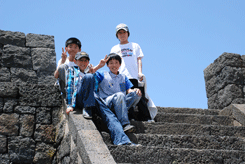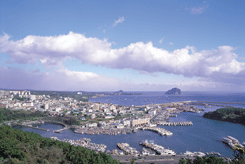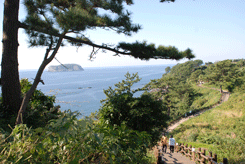EXCURSIONS
Jejudo Highlight 4 days



Tour Highlights
- Jeju Folklore and Natural History Museum
- Hallim Park
- Sanbangsan Tholoid
- Oedolgae Rock
- Cheonjiyeon Waterfall
- Sangumburi Crater
- Seongeup Folk Village
- Seongsan Ilchulbong Tuff Cone
- Darangswi Oreum Trekking
- Bijarim Forest
Click on the days to access the program quick
| Days | Visits and Activities | Distance |
| Day 1 | Seoul - Jeju | 480km |
| Day 2 | Jeju | 130km |
| Day 3 | Jeju | 110km |
| Day 4 | Jeju - Seoul | 560km |
Day 1 Seoul - Jeju (- - -)
480km
 Your tour guide greets you in your hotel and takes you on an excursion to Jeju. An hour flight places you in the most famous of the 3,300 islands of Korea. Towering over the island is Korea's highest peak, Mt. Halla, an extinct volcano topped by a huge crater. Jejudo was once a place of exile for those who fell out of favor with the Korean court, but it has today become the most popular tourist destination.
Your tour guide greets you in your hotel and takes you on an excursion to Jeju. An hour flight places you in the most famous of the 3,300 islands of Korea. Towering over the island is Korea's highest peak, Mt. Halla, an extinct volcano topped by a huge crater. Jejudo was once a place of exile for those who fell out of favor with the Korean court, but it has today become the most popular tourist destination.
Drive past Gwandeokjeong, the oldest building in Jeju which was previously the site of government offices in the period of the Joseon dynasty (1392-1910). On its front stand two Dolharubang figures serving as fertility and protective totems only found on Jeju. Both statues have protruding eyes, bulbous nose, tightly closed lips and a phallic symbol head under the brimmed hat. Both arms are bent at the elbow, hands resting above and below a rotund stomach. Many couples and visitors as well come here, each standing to either side, to have their pictures taken with their hands on its nose. A group of buildings in the neighborhood is a restored Mokgwana, which has been the hub of local administration.
Jeju Folklore and Natural History Museum is an excellent facility providing a fascinating insight into the tenacious and independent lifestyle of Jeju islanders, the natural history of geological features and marine organisms, including plants, animals and minerals native to Jeju Island. Outdoor exhibition is highlighted by millstones, grave guards, tombstones and various stone tools used for daily living.
Day 2 Jeju (B) 130km
Spend a full day exploring western half of the island, including many of the top attractions of Jeju. Hallim Park is a subtropical botanical garden that is strongly scented with exotic sentiment. Every turn brings new surprises. You cannot miss out two unusual caves, one has both stalactites and stalagmites in it while the other is the only spot in the world that is actually a cave within a cave.
Sanbangsan is up next and you will see a magnificent trachyte cone abruptly rising 395 meters by the sea that lacks crater on its summit. Access to the grotto is steep stairs up for 10 minutes. There is a tiny cubbyhole of the 10 meter cave with a small pool and a stone Buddha surrounded by burning candles. The grotto's aura is enchanting with the welcoming scent of incense hanging heavily and the sound of water steadily dripping into the pool. The views from the grotto over the coastal fields, offshore islands, and the ocean are absolutely stunning.
Oedolgae needle rock stands alone off the cliffy coast holding a sad legend of old fisherman. Rising over 20 meters, it creates an awesome coastal view with its perfect backdrop of ocean and outlying islands. It is a great place to soak in the area's barely-touched nature amid fresh ocean breeze.
Tour also includes Cheonjiyeon waterfall cascading down a cliff 22m high and 12m wide into a pool inhabited by giant eels and surrounded by lush vegetation. The tour involves a short walk through subtropical woods, the home to more than 400 individual species of plants and animals. In fact, the diversified biosphere is one of the most unique on the island, making your walk so relaxing and enjoyable - a peaceful way to spend some time with nature.
Day 3 Jeju (B) 110km
With another day of further exploration of the fascinating culture and natural wonders of Jeju. The day begins with a tour of Sangumburi, the only Maar in Korea. The access to the main viewing area is very easy. This spectacular crater is well over 2km in circumference, about 650m in diameter and 100m deep in that it could be easily mistaken for a circular stadium. The views in every direction with sprawling eulalia fields, stunning panoramas of the ocean, and volcanic cones dotting the island's landscape are absolutely breathtaking.
Experience the heritage of the Jeju people and soak up the local culture in Seongeup folk village where nearly 400 traditional thatched houses are still fully functioning. Scattered among the village are many houses that you can enter yourself and look around. Jeongnang gates are some of good examples that represent a beautiful tradition and culture of this friendly people with No Thief, No Beggar, and No Gate. While not overly exciting, the tour gives you a chance to get a glimpse into some of Jeju's unique culture.
You are treated to the UNESCO World Natural Heritage site of Seongsan Ilchulbong. Known as Sunrise Peak, it is the island's largest tuff cone which is surrounded on three sides by the ocean rising 182 meters strait from the water. You may wish to climb this steep cone up to the spectacular crater. A great for photos every step of the way!
Next up is Haenyeo Museum showcases the women diver's harsh work and life as well as their strong tenacity. The display includes the tools, diving outfits, as well as diving techniques and a full-size replica of a traditional women diver house including a primitive log raft that once used for fishing.
End the day at Dongmun Market, one of Jeju City’s most atmospheric bazaars. Wander through covered alleys filled with stalls selling fresh seafood, tropical fruits, handicrafts, and street snacks like tteokbokki, black pork skewers, and hallabong citrus desserts. It is a lively place to mingle with locals, sample regional flavours, and absorb the everyday rhythm of Jeju life.
Day 4 Jeju - Seoul (B) 560km
With leisurely time to pack, drive to Darangswi Oreum for an overall 2-hour Trekking. “Oreum” is a parasitic volcano in Jeju word. On the ground beside the Darangswi, there are thick weeds and cidars, but trees are sparse on the top of it. Darangswi is a rare example of a regular round contour with an asymmetrical slant. About 40 minutes fatiguing and inspiring walk brings you up to the rim of the impressive crater, where you will loop around the rim of 1.5km while enjoying the landscapes spreading below and a 115m deep crater. Being closer to the summit, the rim gets narrower, and you will soon find yourself scaling on to the peak. The wind often gets stronger, but this refreshing air stimulates your senses.
After trekking, stroll through Bijarim featuring a dense evergreen forest of the pine tree Torreya cunifera. Enjoy an oriental nutmeg forest known as the largest one in the world consisting of a single species. A total of 2,878 nutmeg trees that are between 300 to 800 years old with a height of 7 to 14 meters are growing on an area of 450,000㎡. And at the center of the forest stands a single specimen that is 800 years old. A leisurely walk through this lovely forest is refreshing and perhaps a perfect combination of your Oreum trekking.
with the cliffs, the sea, and several small islands offshore. Return late afternoon flight to Seoul.






